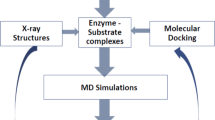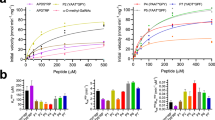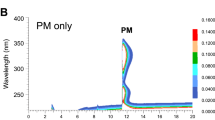Abstract
THE cycloamyloses (CnA) are α-1, 4-linked cyclic oligomers of D-glucopyranose, which have attracted considerable attention as enzyme models1. These doughnut-shaped molecules have the primary hydroxyl groups from the 6-position of the glucose residues at one side of the torus, and the secondary hydroxyl groups from the 2- and 3-positions at the other. On the inside of the cavity there is a ring of CH groups, a ring of glycosidic oxygens, and a further ring of CH groups, resulting in a hydrophobic ether-like interior. The ability of the cycloamyloses to form stable complexes with a variety of organic compounds by inclusion within the hydrophobic cavity has prompted their use as models for the active sites of enzymes. Of particular interest is the observation that they can accelerate the release of phenols from a variety of aryl esters2 and of anilines from anilides3 by a reaction pathway similar to that observed for the hydrolytic enzyme α-chymotrypsin. Furthermore, a marked degree of substrate specificity is observed: thus, the cleavage of meta-substituted aryl acetates is accelerated more than that of their para-analogues2. It has been suggested that this specificity is due to the closer positioning of the nucleophilic secondary hydroxyl group of the cycloamylose to the ester carbonyl in the meta complex than in the para complex2. To test the validity of this hypothesis we have made an X-ray crystallographic study of a series of meta- and para-substituted acetanilides and report here on the 1:1 complex of C7 A with p-nitroacetanilide (PNA).
This is a preview of subscription content, access via your institution
Access options
Subscribe to this journal
Receive 51 print issues and online access
$199.00 per year
only $3.90 per issue
Buy this article
- Purchase on Springer Link
- Instant access to full article PDF
Prices may be subject to local taxes which are calculated during checkout
Similar content being viewed by others
References
Griffiths, D. W. & Bender, M. L. Adv. Catalysis, 23, 209–261 (1973).
Van Etten, R. L., Sebastian, J. F., Clowes, G. A. & Bender, M. L. J. Am. chem. Soc. 89, 3242–3253 (1967).
Komiyama, M. & Bender, M. L. J. Am. chem. Soc. 99, 8021–8024 (1977).
Stezowski, J. J., Jogun, K. H., Eckle, E. & Bartels, K. Nature, 274, 617–619 (1978).
Hamilton, J. A., Sabesan, M. N., Steinrauf, L. K. & Geddes, A. Biochem. biophys. Res. Commun. 73, 659–664 (1976).
Saenger, W. in Environmental Effects on Molecular Structure and Properties (ed. Pullmann, B.) (Reidel, Dordreicht, 1976).
Harata, K. Bull chem. Soc. Japan 50, 1259–1266, 1416–1424 (1977).
Hamilton, J. A., Steinrauf, L. K. & van Etten, R. L. Acta crystallogr. B 24, 1560–62 (1968).
Stewart, J. M., Kruger, G. J., Ammon, H., Dickinson, C. H. & Hall, S. R. X-ray 72 system Tech. Rep. TR 72–192 (Computer Science Center, Univ. Maryland, 1972).
Dodson, E. J., Isaacs, N. W. & Rollett, J. S. Acta crystallogr. A 32, 311–5 (1976).
Motherwell, W. D. S. Pluto, A Program for Plotting Molecular and Crystal Structures, (University Chemical Laboratory, Cambridge).
Author information
Authors and Affiliations
Rights and permissions
About this article
Cite this article
HARDING, M., MACLENNAN, J. & PATON, R. Structure of the complex cycloheptaamylose–p-nitroacetanilide. Nature 274, 621–623 (1978). https://doi.org/10.1038/274621a0
Received:
Accepted:
Issue Date:
DOI: https://doi.org/10.1038/274621a0
This article is cited by
-
Induced circular dichroism spectra of the cyclodextrin complexes with 2-Thioxo-1,3-benzodithiole and 2-Selenoxo-1,3-benzodithiole
Journal of Inclusion Phenomena and Molecular Recognition in Chemistry (1990)
-
Induced circular dichroiism spectra of benz[b]anthracene included in?-cyclodextrin
Journal of Inclusion Phenomena (1987)
-
Metastable crystals of β-cyclodextrin complexes and the membrane diffusion model
Nature (1979)
Comments
By submitting a comment you agree to abide by our Terms and Community Guidelines. If you find something abusive or that does not comply with our terms or guidelines please flag it as inappropriate.



